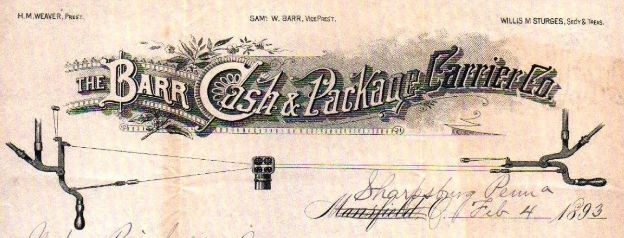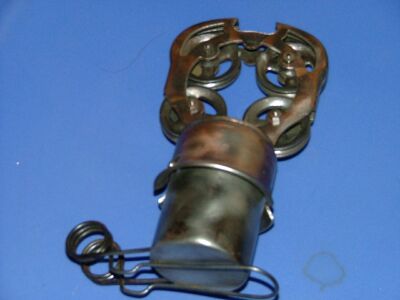
THE CASH RAILWAY WEBSITE |
||||||||
| Home | Manufacturers | Cash Balls | Wire systems | Cable systems | Pneumatic systems | Locations | References | Patents |

Samuel W. Barr was born at Haggerstown, Md. on 20 July 1829, the son of Col. Jacob Barr. He was one of the gold seekers of [18]49 in the Californian El Dorado and then became well known as an inventor. He invented the Little Giant plow and in 1885 a cash and package carrier. He died at 10 am on the 20th of January, 1903 at his home at 58 West Fourth Street, Mansfield, Ohio. (Mansfield News 20 Jan. 1903, p.6)
With his brother, Jacob Harrison Barr, he set up the Barr Cash and Package Carrier Company in Mansfield. Jacob was born on 20 August 1838 and lived to at least 90. Mansfield News, 20 August 1928. The company was founded in 1888. Scott Schaut. Historic Mansfield, p.39
"Henry M. Weaver came to Mansfield in 1869 and was one of the founders of the Weaver, Jones & Company, wholesale shoe dealers. The business was liquidated in 1892 and at that time Mr. Weaver became associated with the Barr Cash Carrier Manufacturing Company, which was later merged with the Lamson Manufacturing Company, of Boston, Mass., and Mr. Weaver continued as manager of the company. He was also president of the Mansfield Gas Company." Heritage Pursuit website. There is a patent of 1891 for Henry Weaver assigned to the Barr Cash and Package Carrier Company.
There was a law suit between the Barr Company and W.S.Lamson in 1888 regarding a derogatory circular - see Court Cases. Known installations are Barnett's in Bedford, Pa. in 1899; Williams & Norton in Rome, NY in 1900 and The Grand Leader store of McLeansboro, Ill. in 1900.
A notice in the Clothier and Furnisher (date unknown) announced that "G.S.Powell, manager of the Barr Cash and Package Carrier Co., 132 Clark st., would be pleased to illustrate their system to all merchants visiting Chicago." ( p.86)
Another mention in the press was: "Agent of the Barr Cash Carrier, of Mansfield, made a trip to this town on last Friday, with a view of placing in our stores a cash carrier; but met with poor success, our merchants had to state the fact that business was so dull that they would not be justified in adding such an improvement." (Ohio Democrat [New Philadelphia], 24 Apr. 1890, p.1)
In 1889, the stock of the Barr company was sold to Lamsons (New York Times, 7 Dec. 1889) and Samuel Barr received a large payout. It was "the biggest business transaction of the year" in Mansfield. The name of the company was retained, however, and in 1907 there was a court case against Brooks-Ozan Mercantile Co. at the Supreme Court of Arkansas.
In the Indiana Tribune of 23 January 1904, p. 8 the Barr Cash & Package Carrier Company, Ohio, with a capital of $100,000 is listed under "Neue Incorporationen" and the incorporators are Beaver, B.R. Sturges, L.N.Strong, J.E.Tracy, S.W.Barr, B.H. Albaugh and J.H.Barr. (Initials uncertain due to the script.)
The Barr carrier (later the "Lamson-Barr carrier) was a two-wire system. Pulling down the lever at one end of the line spread the two track wires behind the wheels of the car, so propelling it towards the other end. This is the same principle as the Gipe carrier but it also "combined the lever and the wedge." It was further claimed to be unique in that it permits the operator to propel the car at will in either direction. No carrier could compete with it in durability. There were no springs to weaken, no elastics to break and no cords to wear and fray - simply two levers and two wires. The action was practically noiseless. Nor could any carrier compare with it for severe grades because of the continuous propulsive force.
Over 30,000 stations of Lamson-Barr cash carriers were in service in the US and Canada in the early 20th century with several thousand more in other parts of the world. There is an illustration of the Lamson "Express" system with somewhat similar cars on the cars page.
The complete line with the wires together on the left (handle horizontal) and spread on the right (handle vertical). |
|
|
A three-line home station with the car on the middle line being "in". On arrival the car is arrested by a coiled spring round the lower wire and is held by a wire retainer at the top to prevent rebounds. |
A dismantled Barr propulsion, probably replated. (Courtesy of Gene Davidson) 
A plainer design of Barr system car, as shown in the drawing above. Unlike the Rapid and Air-Line systems, the whole car, cup and wheels are made of metal. The cup is of stamped steel and if required was fitted with a "message clip" to carry cheques, pass books, etc. The standard finish was oxidized copper but other finishes could be made to order.
|
A very ornamental car, probably from a Barr system judging by the 4-wheel design. |